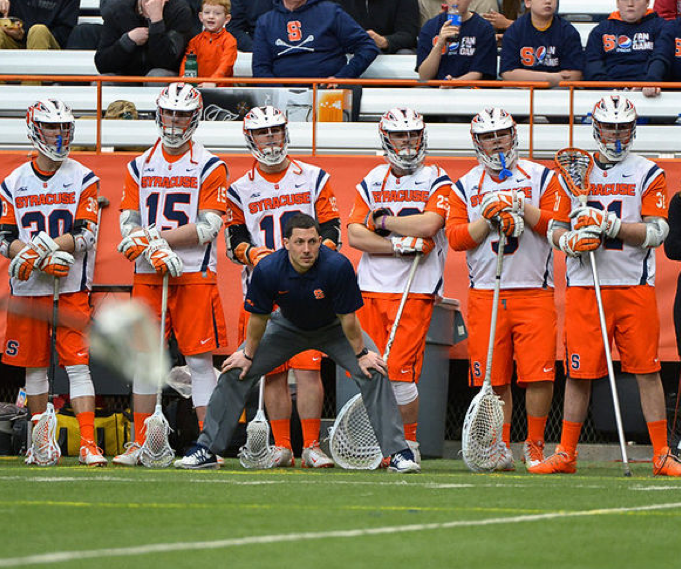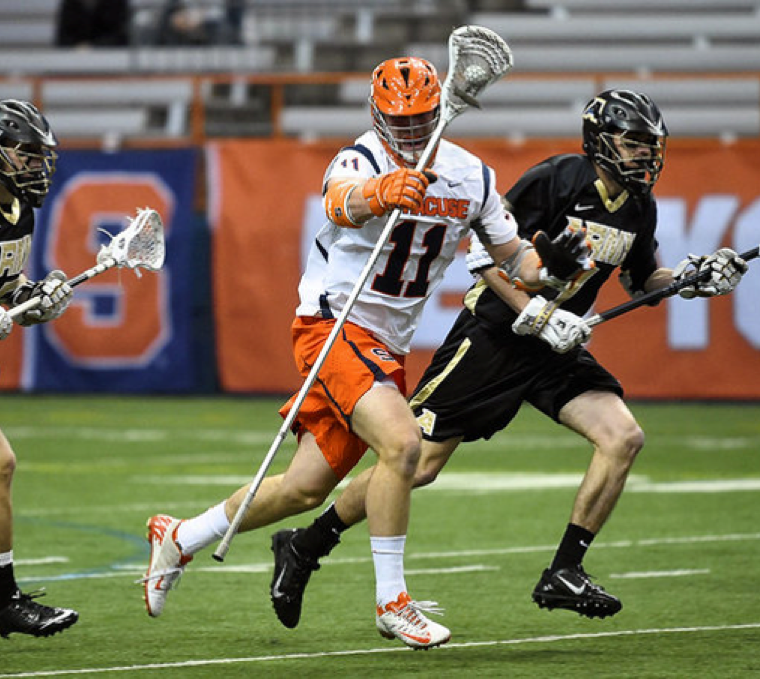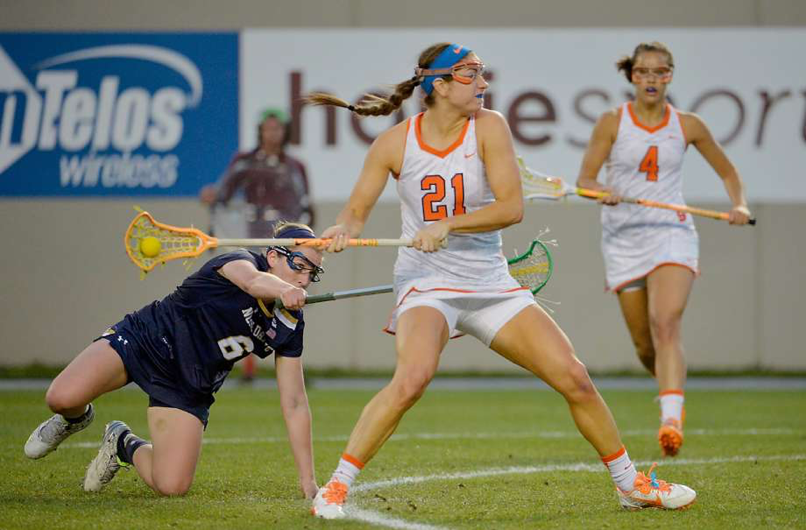How does a strength coach train for performance without having ever played the sport?
Using Sound Strength & Conditioning Principles for the
Lacrosse Athlete:
By: Matt Mancz

I have never played lacrosse. I have been the strength and conditioning coach for the Syracuse men’s and women’s lacrosse programs since 2013. I am from Levittown, New York, located on Long Island. Long Island is a popular place for the sport of lacrosse; however I grew up playing baseball. My best friends’ father was our baseball coach, and would never entertain the idea of us switching sports. I will always love baseball, but I will always be curious as to what would happen if I picked up a stick. I will never know what it actually ‘feels’ like to play lacrosse. You can argue that lacrosse is more ‘athletic’ than baseball- and who doesn’t enjoy things that make us feel athletic.
As most young strength coaches experience, you are often dealt training sports teams that you have no prior experience playing. Playing baseball for the majority of my life as well as playing Division III football in college (D3 Nation!), being handed Syracuse Lacrosse at 23 years old was an enormous opportunity for me. I remember getting a serious feeling in the gut of my stomach. I was a bit nervous and frequently asked myself something like ‘What the sh*t did I get myself into here?’. But that is exactly why we all choose this profession. We invite challenges, we sacrifice comfort for progress, and we aim to construct a culture of hard work and resiliency, regardless of what sport it is.
 How did I begin training a sport that I have never played? Before we answer this question, we have to admit that lacrosse is still evolving. It is still growing all over the world, and the strength and conditioning component paired with lacrosse is even younger. We are still learning what the best way to train the lacrosse athlete is. Is it with a football background? With concepts of soccer? What about some principles of training baseball players? Don’t forget hockey!
How did I begin training a sport that I have never played? Before we answer this question, we have to admit that lacrosse is still evolving. It is still growing all over the world, and the strength and conditioning component paired with lacrosse is even younger. We are still learning what the best way to train the lacrosse athlete is. Is it with a football background? With concepts of soccer? What about some principles of training baseball players? Don’t forget hockey!
Early On
What helped me early on was attending every practice and analyzing everything. Watching the drills, the tempo, the movements, the physicality, everything. Working with football gives you enough practical knowledge to construct a basic strength program, but is it as specific as it can be to the sport you train? Everything we do slightly changes every single year. I am constantly trying to tweak little things here and there with the objective to give my laxers the best program I can. As my program has evolved over the years, the basics and foundations remain the same. We squat, deadlift, jump and sprint.
When I began to think about what our players needed, it was obvious. Strength. Relative strength is our foundation, as simple as it gets. I aim to get our players, men laxers or women laxers, as strong as possible, pound for pound. I am trying to lower their body fat percentage while adding pounds to their squat and deadlift. I can measure our progress from this example: Three years ago, when our women’s lacrosse players would begin a workout, we would setup for box squats. They would reach for the 10 pounds plates to put on the bar. Today, our women are now reaching for the 45-pound plates, performing speed reps off a box with 135 pounds. This doesn’t happen overnight.
 Trial and Error
Trial and Error
When developing programs the truth is it takes a large amount of trial and error. I look back at the programs I put my athletes through and usually am saying something like ‘wtf was I thinking’. You have to be willing to make minor changes while also staying true to your long-term goal. For example, let’s look at strength. We are looking at the interplay of three factors: Load, frequency, and freshness. Load would be considered the amount of weight on the bar. Frequency would be how many sessions during the week you are handling a significant load, around 80%. Freshness would generally be considered your overall mood, energy levels, and how your body feels. The most important tool we use to measure freshness: conversation and observation (sorry it is not an app). I heard Brett Bartholomew use these two words at the NSCA convention in January. You should be asking your athletes how they feel everyday. Most of the time you will have your ‘complainers’ complain about soreness and question why they are squatting twice a week during an in-season cycle. But you also have to observe them. Look at their expressions in the morning, their body language, how they are moving the weight. If your best athletes are struggling for more than week, pull back on the throttle. Make your minor adjustments, but do not sacrifice your long-term goal. Making the adjustments is the ‘art’ of the profession. It takes experience and trial and error. And let me be clear, I am in no sense of the word an expert in the profession. I am 27 years old and still have a ton to learn in this field. But I am not afraid to try new things and I will always have an open mind in regards to ANYTHING involved with athletic development.
Relative strength is our foundation but there are many more things we look to improve. For example we look at overall work capacity and conditioning level, lactic and alactic energy systems, hypertrophy, developing power and improving RFD, teaching deceleration as a skill, teaching acceleration as a skill, true max velocity speed development, rotational power, and above all durability and injury prevention. If I was to break this down by the year, we aim to develop the following in the offseason: relative strength, hypertrophy and improved body composition, work capacity, lactic and alactic systems, power and RFD, deceleration, acceleration, max velocity, rotational power, and injury prevention. During an in-season phase, I keep it simple: durability, relative strength maintained and improved, power maintained, and overall conditioning levels peaking as season progresses.
R.O.I.
A disadvantage we have training college lacrosse is that we have very limited time to develop in the offseason. Right off the bat, our kids are home for the summer. When they arrive in the fall, we start fall ball within two weeks. Sometimes practices run 5x a week with scrimmages on the weekends. Overall the fall ball season can last 6-7 weeks. Our semester is 14 weeks total, which leaves us about half of the semester to really train balls out. And once we start to see progress, our kids go home for winter break right before we start the season. We have to budget our time wisely and chose exercises that are going to give us the most return on investment.
 Let the Fun Begin
Let the Fun Begin
The way we train during the fall ball season has an in-season feel to it. We need to develop, but we also need to be fresh. When fall ball ends that’s when the fun starts. This is where we really aim to progress. We handle loads, we handle them more frequently, and generally speaking we are fresher because we are not practicing. This is also the time we implement conditioning and speed skill acquisition. We teach acceleration, deceleration, and max velocity running. Some new things I am starting to develop are position specific speed and agility drills for the offseason. For example, I would have all our attackmen and only attackmen for 40 minute speed and agility sessions. Then I would work with our midfielders, and finally our defensemen. All groups would be run separately. My objective was to design drills that would match the demands of their position so they could move more efficiently on the field. I give credit to Coach Desko for pointing this out to me. He was observing some drills we were doing one day, and he mentioned to me that our defensemen go backwards way more than an offense midfielder does. This forced me to make small adjustments and look at the movements specific to each position. Goalies and fogos would also be separate, which I experiment with too. Our goalies and fogos don’t like to run but they love to work. We do some very interesting things with them. The fogo position is such a unique position that you have to train them differently. I am fortunate enough where I only work with the men’s and women’s lacrosse teams, so I can devote all my time to them. We also have access to two indoor turf fields, which helps with the weather in central New York.
In-season vs Offseason
Your offseason program should lead into what you plan on using during the season. If your offseason is your major engine and transmission job, your in-season program is the oil change and tire rotation job. This is where the freshness component is the most crucial. During the season you still need a load, you still need frequency of the load, but you need to monitor freshness with upmost importance. You need to make adjustments if your men and women are not fresh. Most weeks of the season, we handle 80% early in the week, with no sets more than 3 reps. Mid week, if we are fresh, we handle 50% for speed reps of 2. We end the week with mobility and soft tissue work. That is very vague, but a simple description of our in-season lifting program. We usually condition 1-2x each week, again depending on freshness.

Does it work?
It has taken years of making changes, hundreds of conversations and countless hours of observation to see results training lacrosse. I have flashbacks to when I first starting working with the men’s team. I told our guys we were going to be in the squat rack and I had guys sneaking out and hiding on the treadmill. It is different now. Our players have bought in to our system and our unique way of doing things. I tell my players straight up: I am not normal. We try to be different here and I want you to be different with me. I want you to walk around campus and realize that you are different than 99% of the people you see. I want you to become hardened by the process and resilient to anything you face, on the field and off. It starts with their buy in factor. Once you have them bought in, there are no limits to what they can achieve. Some laxers don’t see the weight room as a big part of their performance on the field. I would like the think it is a little different here. Not my guys.
Thank You
I want to thank these coaches for having a profound impact on what I do: Will Hicks, Hal and Kristen Luther, Corey Parker, Kevin Donahue, John Desko, Lelan Rogers, Roy Simmons III, Scott Shafer, Jason Rebrovich, and Sean Smith. I’d also like to thank Kevin Rice and Dylan Donahue for starting with me as small, weak, undersized attackmen, and leaving as physically dominant forces on the lacrosse field. Also, Randy Staats, who showed up out of shape and lazy, and left with a respectable work ethic. Also, to all the athletes I work with today. I demand you to be better versions of yourselves, which in turn, makes me demand more of myself. Thank you.
About the Author:
 Matt Mancz is the strength and conditioning coach for the Syracuse men’s and women’s lacrosse teams. He has also previously worked with the Orange football program for four seasons. In his time at Syracuse, the football team won the 2012 New Era Pinstripe Bowl, the 2013 Texas Bowl and both lacrosse squads have advanced to the Final Four with the 2013 Orange men reaching the NCAA championship game and the Orange women making the 2014 NCAA final, highlighting a string of five-straight final fours during Mancz’s tenure.
Matt Mancz is the strength and conditioning coach for the Syracuse men’s and women’s lacrosse teams. He has also previously worked with the Orange football program for four seasons. In his time at Syracuse, the football team won the 2012 New Era Pinstripe Bowl, the 2013 Texas Bowl and both lacrosse squads have advanced to the Final Four with the 2013 Orange men reaching the NCAA championship game and the Orange women making the 2014 NCAA final, highlighting a string of five-straight final fours during Mancz’s tenure.
On both the men’s and woman's teams, Mancz has worked directly with many Syracuse University All-Americans. Mancz also serves as strength and conditioning coach for the Canadian women's national team, under their coach, Gary Gait.
Mancz, who earned his bachelor’s degree in kinesiology, now currently working on his master's degree in exercise science, was a member of the Cortland football team in 2009 and 2010. He is certified as a strength and conditioning specialist (C.S.C.S) by the National Strength and Conditioning Association (NSCA).

0 Comments for “How does a strength coach train for performance without having ever played the sport?”